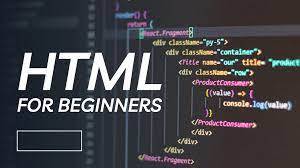To program using HTML (Hypertext Markup Language), follow these steps:
1. Set up your development environment:
- Install a text editor or integrated development environment (IDE) on your computer. Some popular choices are Visual Studio Code, Sublime Text, Atom, or Notepad++.
- Create a new file with a `.html` extension to write your HTML code.
2. Start with the basic structure:
- Begin your HTML document with the `<!DOCTYPE html>` declaration, which specifies the HTML version.
- Create the HTML document by adding `<html></html>` tags. Everything within these tags is considered the HTML code.
- Inside the `<html>` tags, include `<head></head>` and `<body></body>` tags.
3. Add the head section:
- The `<head>` section contains meta-information about the HTML document, such as the page title, character encoding, and linked stylesheets or scripts.
- Within the `<head>` tags, include the `<title></title>` tags to define the page title that will appear in the browser's title bar.
- You can also include other meta tags, stylesheets, or scripts within the `<head>` section.
4. Structure the content within the body section:
- The `<body>` section is where you define the visible content of your webpage.
- Use various HTML tags to structure and format your content. For example:
- `<h1></h1>` for headings
- `<p></p>` for paragraphs
- `<ul></ul>` for unordered lists
- `<ol></ol>` for ordered lists
- `<a></a>` for links
- `<img>` for images, etc.
5. Add attributes and content to the HTML tags:
- HTML tags can have attributes that provide additional information or functionality. Attributes are specified within the opening tag.
- For example, the `<a>` tag can have the `href` attribute to define the link destination:
```html
<a href="https://example.com">Visit Example</a>
```
6. Save your HTML file:
- Save your file with the `.html` extension (e.g., `index.html`).
7. Preview your webpage:
- Open the HTML file in a web browser to see how it looks. Simply double-click the file, and it will open in your default browser.
8. Modify and enhance your HTML code:
- You can continue to edit your HTML file to add more content, apply styles using CSS, or include interactive functionality using JavaScript.
Remember that HTML is a markup language for structuring content, so it defines the structure and presentation of a webpage. To style your HTML or add interactivity, you may need to use CSS (Cascading Style Sheets) and JavaScript, respectively.
This is just a basic overview to get started with HTML programming. There are many more HTML tags and attributes available for different purposes. You can refer to online tutorials, documentation, or HTML reference guides for more in-depth knowledge and advanced techniques.


